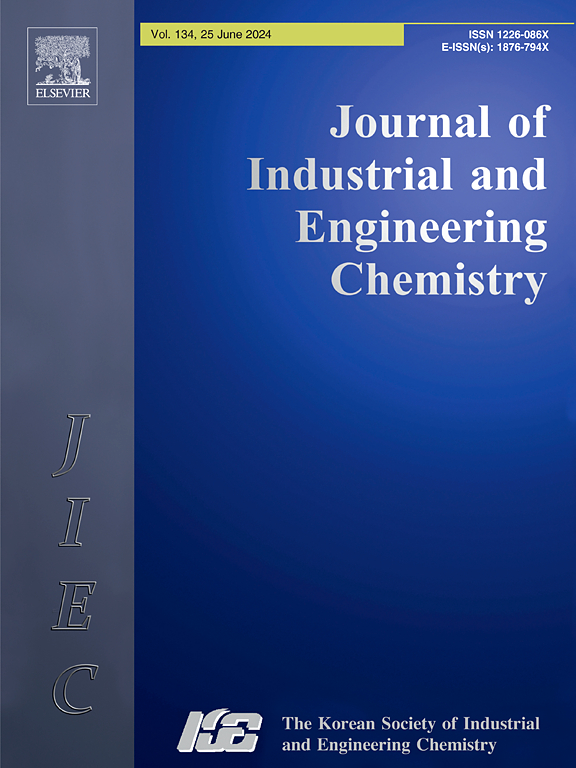聚乙烯醇/壳聚糖/铜纳米线体外创面敷料水凝胶的合成及综合表征
IF 5.9
3区 工程技术
Q1 CHEMISTRY, MULTIDISCIPLINARY
Journal of Industrial and Engineering Chemistry
Pub Date : 2024-11-17
DOI:10.1016/j.jiec.2024.11.029
引用次数: 0
摘要
这项工作的特点是合成了一种伤口敷料水凝胶,并轻松合成了非氧化物铜纳米线(宽高比:5000,长度>;100 μm),合成聚乙烯醇(PVA)/壳聚糖基体,TEOS交联,添加甘油增强柔韧性。在纳米线的作用下,合成的伤口敷料具有良好的力学性能,抗拉强度为58.76 MPa,伸长率为124.78%,膨胀性能达到290%。生物降解表现出高度的结构稳定性和一致性,纳米复合材料的生物降解在7天内仅损失9.6 - 21.5%,在14天后仅损失21 - 27.6%。MTT生物学评价显示,人真皮成纤维细胞(HDF)细胞存活率为95 ~ 103%。对MCF-7癌细胞的评估也进行了,90%的存活率显示纳米复合材料有轻微的抗癌活性。伤口愈合划痕实验显示,HDF细胞在72 h内具有较高的细胞迁移、伤口闭合和伤口愈合,同时抑制MCF-7癌细胞的生长。此外,采用96孔微量稀释试验测量了其抗菌活性,对革兰氏阳性(金黄色葡萄球菌)和革兰氏阴性(大肠杆菌)的抗菌活性均在50 - 97%左右,表明所设计的纳米复合水凝胶伤口敷料在伤口愈合和治疗方面具有很大的潜力。本文章由计算机程序翻译,如有差异,请以英文原文为准。

Synthesis and Comprehensive Characterization of PVA/Chitosan/Cu Nanowires Wound Dressing Hydrogel for Effective In Vitro Wound Healing
This work features the synthesis of a wound dressing hydrogel, with the facile synthesis of the non-oxide copper nanowires (aspect ratio: 5000, length > 100 μm), and the synthesis of Polyvinyl Alcohol (PVA)/Chitosan matrix, crosslinked by TEOS, with enhanced flexibility by addition of Glycerol. The synthesized wound dressing showed high mechanical performance under the influence of nanowires, exhibiting 58.76 MPa tensile strength and 124.78 % elongation, also affecting the swelling behavior reaching 290 % swelling capacity. Biodegradation showed high structural stability and consistent biodegradation, losing only 9.6–21.5 % for nanocomposites in 7 days and 21–27.6 % after 14 days. Biological assessment by MTT assay showed 95–103 % cell viability on the human dermal fibroblasts (HDF) cells. The assessment on the MCF-7 cancer cells was also carried out where 90 % survival showed slight anticancer activity from the nanocomposites. Wound healing scratch assay showed high cell migration, wound closure, and wound healing in 72 h on HDF cells, while inhibiting the growth of MCF-7 cancer cells. Furthermore, the antibacterial activity was measured using a 96-well microdilution test exhibiting good antibacterial activity ranging around 50–97 % against both gram-positive (S. aureus) and gram-negative (E. coli) bacteria, suggesting that the designed nanocomposite hydrogel wound dressing has great potential for wound healing and treatment.
求助全文
通过发布文献求助,成功后即可免费获取论文全文。
去求助
来源期刊
CiteScore
10.40
自引率
6.60%
发文量
639
审稿时长
29 days
期刊介绍:
Journal of Industrial and Engineering Chemistry is published monthly in English by the Korean Society of Industrial and Engineering Chemistry. JIEC brings together multidisciplinary interests in one journal and is to disseminate information on all aspects of research and development in industrial and engineering chemistry. Contributions in the form of research articles, short communications, notes and reviews are considered for publication. The editors welcome original contributions that have not been and are not to be published elsewhere. Instruction to authors and a manuscript submissions form are printed at the end of each issue. Bulk reprints of individual articles can be ordered. This publication is partially supported by Korea Research Foundation and the Korean Federation of Science and Technology Societies.

 求助内容:
求助内容: 应助结果提醒方式:
应助结果提醒方式:


